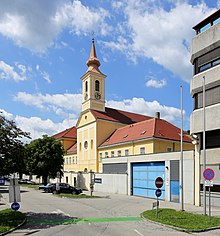Old monastery church of the Stein prison
The old (sometimes also former ) monastery church of the Stein prison was the church of the Redemptorist nuns' monastery in Stein an der Donau in the 19th century . It was built from 1839 to 1843 as part of the construction of the monastery.
Historical background
The monastery church formed the spatial and spiritual center of this order settlement. The Redemptorist Order was founded in Scala on the Amalfi Coast in 1732 by the later bishop and canonized after his death Alfonso Maria de Liguori . In 1749 the order was recognized by Pope Benedict XIV . In 1784 Klemens Maria Hofbauer joined the order. During the time of Emperor Joseph II , the plans of Klemens Maria Hofbauer and other Redemptorists to establish religious branches in Austria could not be put into practice, as the Emperor closed around 800 monasteries during his reign. The establishment of religious branches in Konstanz, in Wollerau as well as in Joinville and Rome was successful. The Redemptorists were expelled from the existing order in Warsaw in 1808 on the orders of Napoleon I. The development of the order was different in Bavaria, where in 1841 King Ludwig I called the Redemptorists to Altötting as pilgrims pastors.
Dissolution of the monastery
Eduard Kranner's book "Krems - Face of a City" describes the dissolution of the monastery: As early as March 17, 1848, the National Guard was set up in Krems, a total of over 800 men, organized in five companies. On April 2, 1848, a national guard was brought into being in Stein. It consisted of 180 men. Instead of the withdrawn garrison, the National Guards had to patrol and keep watch to secure the revolutionary achievements, such as B. freedom of the press, freedom of expression, popular arming in the form of the National Guard and others to ensure. On April 8th, a crowd of thirsty revolutionaries arrived in Krems from Vienna and the following day they penetrated the Redemptorist convent, ordered the nine women religious present to pack their belongings and leave the convent. They had to wait for further instructions in the nearby Göttweigerhof. A note was attached to the monastery gate with the inscription "National property". Since no further orders came, the nuns hid in the city and sought admission from benevolent citizens.
Later the sisters went to Eggenburg and founded a new religious order there. They refused an offer to return to Stein.
Correctional facility
In 1850, the state acquired the abandoned monastery and had a Lower Austrian provincial prison built on the monastery grounds and purchased land to relieve the pressure on the Vienna prison. As a " male and female penal institution " it had a capacity of 150 convicts. In 1854 further expansion measures began, so that at the end of 1858 there was space for 571 convicts and 351 inmates (workhouse inmates). On October 25, 1855, the Order of the Daughters of Christian Love was given by St. Vinzenz von Paul transferred the management and administration of the institution and only left a prison inspector as a state body in the same. On January 1, 1870, the institution went back into pure state administration and was subordinate to the Ministry of Justice. Since then, numerous renovations and new buildings have been carried out on the 5.8 hectare property in order to make the penitentiary system more humane and contemporary. The former monastery church was rebuilt and used for years as an event space for the inmates (e.g. for showing films). In 1996, on the initiative of the head of the institution at the time, Johann Hadrbolec, work began on restoring the church building to its original state as a church, and after completion it was finally blessed on January 27, 1998 by the diocesan bishop Kurt Krenn and given its intended purpose.
Today's use of the monastery church
The former monastery church is now used for various events and in this context is partly open to the public. It is also the link between prison and society. In addition, the contemplative work of the nuns and their pastoral efforts to look after prisoners should also be remembered.
Individual evidence
- ^ Dehio-Handbuch: Lower Austria, north of the Danube, page 599; Berger publishing house, Horn / Vienna 2010
- ^ Eduard Kranner: Krems - face of a city . Verlag Josef Faber, Krems, 1979 edition
Coordinates: 48 ° 24 ′ 21 ″ N , 15 ° 35 ′ 14 ″ E
